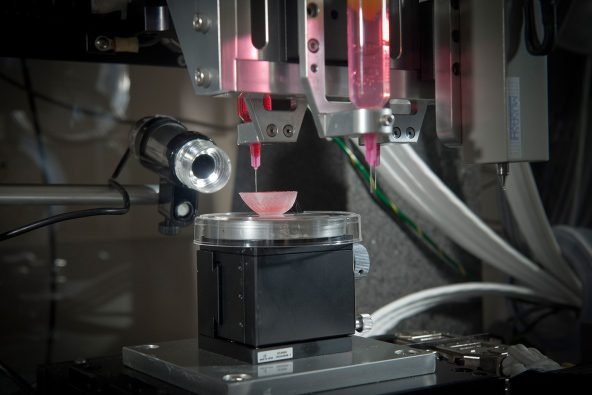In March 2017, a Swedish team of researchers successfully managed to create new tissue from stem cells.
Stem cells have long intrigued scientists, and their importance is becoming increasingly clear. Just this year, the Australian of the Year award went to Alan Mackay-Sim for his work on using stem cells from the nose to treat spinal cord injury.
Whether it’s in our muscles, our bone marrow and even our brains, they are the things responsible for the regeneration of cells. They also have the unique ability to be coerced into differentiating into specific cell types, and this is what makes them so compelling. Harnessing their reparative power has always been a goal for scientists, and now it seems that stem cell research is opening doors in the medical field.
The Swedish study used cells from patients who had undergone knee surgery, reverting them into ‘pluripotent’ stem cells: stem cells that can differentiate into other types of cells. After combining the cells into a nanocellulose compound – which is what allowed them to survive – they were printed into a structure using a 3D bio-printer. Nanocellulose is a bioink, a material made from living cells that acts like a protective blanket around the extracted cells. The addition of growth factors saw the cells proliferate and form a cartilage structure that, under analysis, seems identical to normal cartilage.
In a media release, the leader of the research team, Stina Simonsson explains the technique: ‘We … harvested mediums from other cells that contain the signals that stem cells use to communicate with each other … In layman’s terms, our theory is that we managed to trick the cells into thinking that they aren’t alone.’
Not only is the survival of the cells during the printing stage a first, but the tiny amount of cells actually needed to form the tissue is another. ‘We’re the first to succeed with it’, Simonsson declares, ‘and we did so without any animal testing whatsoever.’ The success suggests that cartilage may be grown from a patient’s own cells, and used to repair cartilage damage in joints, a glimmer of hope for osteoarthritis sufferers in particular.
For stem cells to be accepted into a patient’s body, the body’s immune system cannot recognise the cells as a foreign entity. Usually this requires sourcing from a matching donor. This research should allow cells to be taken from the patient’s themselves, side-stepping this technicality and reducing the risk of cell rejection.
Osteoarthritis is a degenerative joint disease in which cartilage becomes thin and begins to wear away. Damage builds up through the years and is often not detected until it is too late. Though there are treatments to relieve pain, there is no known cure. While Simonsson says that ‘the structure of the cellulose we used might not be optimal for use in the human body [yet]’, this study still presents a leap forward in the ability to regenerate cartilage.
Possibly the most exciting part of the study is stated in the opening of the paper: ‘Three-dimensional bioprinting technology is anticipated to radically change regenerative medicine because it would enable tissues and organs to be printed on demand.’
The success of differentiating stem cells into cartilage, having them proliferate and survive, indicates that other types of specialised cells can be created. As the paper suggests, along with bio-printing technology, this could include organs and even bones.
While the 3D printing of organs may be slightly ambitious for the current moment, this success is still one to be celebrated, and one that holds countless possibilities for the future.
We acknowledge the Ngunnawal and Ngambri people, who are the Traditional Custodians of the land on which Woroni, Woroni Radio and Woroni TV are created, edited, published, printed and distributed. We pay our respects to Elders past and present. We acknowledge that the name Woroni was taken from the Wadi Wadi Nation without permission, and we are striving to do better for future reconciliation.
